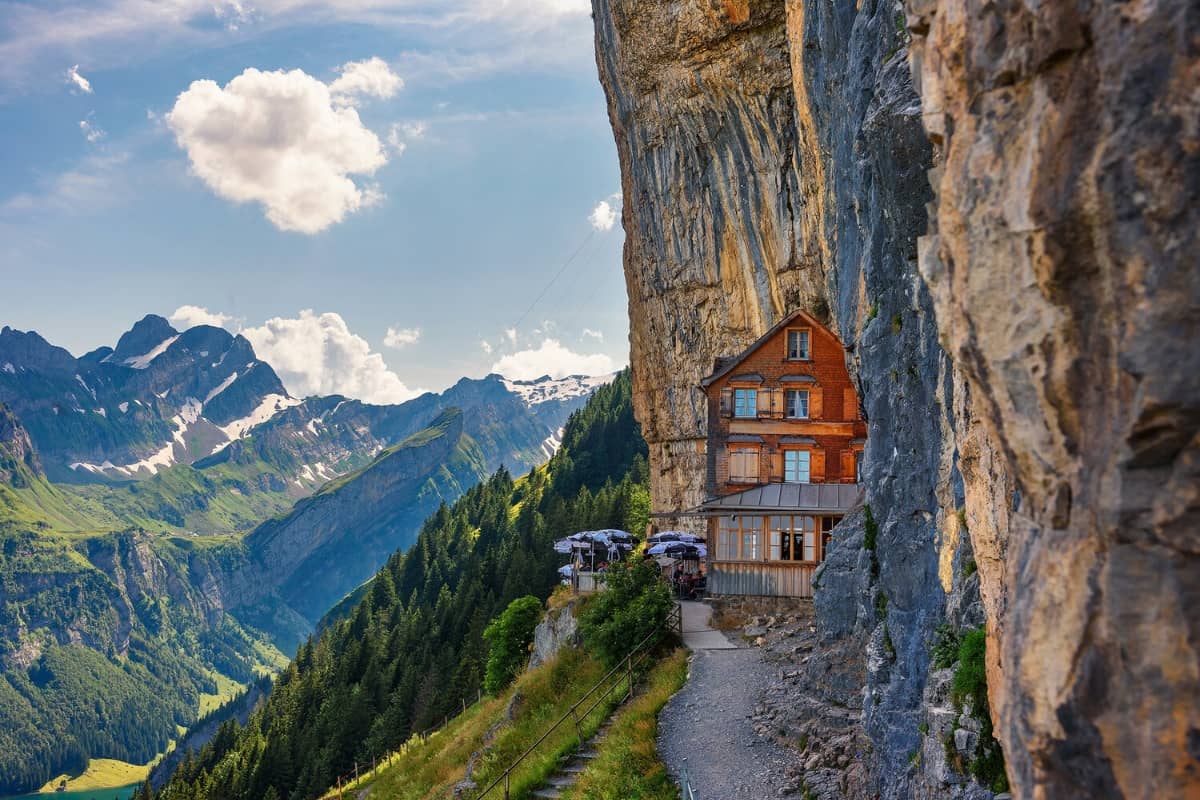The Appenzell region in Switzerland is famed for its breathtaking alpine scenery, charming villages, and a rich hiking culture. While the natural beauty of the Alpstein range draws outdoor enthusiasts, there are also hidden dangers that hikers must keep in mind to ensure a safe adventure. From unpredictable weather to challenging trails, Appenzell Mountain presents risks that can turn a scenic hike into a perilous journey. Here’s a detailed look at the six hidden dangers hikers may encounter in this stunning yet formidable region.
1. Unpredictable Weather in the Alpstein Range
One of the most pressing concerns for anyone venturing into the Appenzell Mountains is the rapid weather changes. The high altitude of peaks like Säntis and Schäfler means that weather patterns can shift drastically in a short period. A sunny day can quickly turn into a cold, foggy, or even stormy one. This unpredictability not only makes the trails more difficult but can also leave hikers underprepared, especially if they don’t carry the right gear. Fog can obscure visibility, making it easy to lose your way, while rain makes the rocky paths extremely slippery.
Hikers are advised to check the weather forecast before setting out and always carry waterproof clothing, extra layers, and safety equipment. It’s crucial to understand that a trail that seemed safe at the start can quickly become treacherous under different weather conditions. Moreover, descending temperatures at higher altitudes can lead to hypothermia, even in the summer.
2. Exposed and Narrow Ridgelines
The Appenzell Mountains are home to several stunning but challenging hikes, such as Schäfler Ridge and Lisengrat, which feature exposed ridgelines. These narrow trails offer breathtaking views but also come with inherent dangers. A misstep on these exposed sections, especially during high winds, can lead to severe injuries or worse. The trail from Säntis to Altmann, for example, is known for its technical difficulty and should only be attempted by experienced hikers.
Steep drops on either side of the ridgeline make these hikes especially dangerous in wet or windy conditions. It’s recommended to avoid these hikes in bad weather and always walk with caution. While the ridges provide some of the best views in the region, they should be approached with a strong sense of safety and respect for the mountain’s raw power.
3. Challenging Terrain with Steep Ascents and Loose Rocks
The hiking trails in Appenzell, such as those leading to the famous Aescher Restaurant or the Schäfler Ridge, are not only steep but often involve rocky and uneven surfaces. Hikers may need to use chains at certain points for additional support, especially on the climb from Seealpsee to Aescher, which is secured with chains in the steepest sections. This terrain can be tricky to navigate, especially for those unfamiliar with mountain hiking.
Loose rocks pose an additional danger, particularly on descents. Losing footing on the loose gravel or rocks can result in serious falls, and even minor slips can lead to twisted ankles or sprains. Having the right footwear with good grip is crucial to handling these surfaces, and trekking poles can offer much-needed stability.
4. Remote Areas with Limited Emergency Access
While the Appenzell region is relatively well-developed with trails and huts, there are remote sections, especially on longer hikes like the Alpstein Loop or Saxer Lücke, where emergency access is limited. In case of accidents, such as falls or medical emergencies, help can take time to arrive, especially on the more isolated ridgelines or less trafficked routes.
Given the remoteness of certain areas, hikers should always inform someone about their planned route and expected return time. Carrying a fully charged phone with emergency contact numbers and a first-aid kit is essential. Additionally, downloading offline maps can be a lifesaver if you lose your way in fog or other adverse conditions.
5. High-Altitude Wildlife Encounters
The Appenzell region is home to some rare and fascinating wildlife, particularly at higher altitudes. While encountering animals like ibex or chamois can be an exciting experience, it also poses certain risks. These animals, though generally wary of humans, can become unpredictable if startled, especially if they feel cornered on narrow trails.
It’s important to keep a safe distance from wildlife and never attempt to feed or approach them. In some cases, hikers may come across herds of cows, particularly on trails like the Schäfler Ridge, which can block narrow paths and cause congestion. While these domestic animals are generally harmless, it’s essential to remain cautious, as sudden movements or loud noises could startle them.
6. Slippery Trails After Rain
Rain transforms Appenzell’s rocky and steep trails into hazardous pathways. The combination of moisture and loose gravel makes descents particularly dangerous. Even popular and relatively easier hikes, like the one to Seealpsee, can become risky after a downpour. In such conditions, the rocks become slick, and the risk of slipping increases exponentially.
In fact, some trails, such as those leading to the Schäfler Ridge, become particularly treacherous after rain due to the narrowness and the incline of the path. Hiking poles can provide extra support, and it’s always a good idea to wait for the trails to dry out if possible. If you must hike during or after rain, taking slow, careful steps and ensuring your boots have proper grip can prevent unnecessary accidents.
Conclusion
Hiking in the Appenzell Mountains offers an unforgettable experience, with its stunning vistas, crystal-clear lakes, and iconic ridges. However, it’s important to approach these trails with a strong sense of caution and preparation. The unpredictable weather, exposed ridgelines, challenging terrain, remote areas, wildlife, and slippery trails all present hidden dangers that can easily catch hikers off-guard. With the right gear, planning, and awareness, you can enjoy the beauty of this alpine wonderland while minimizing the risks.






